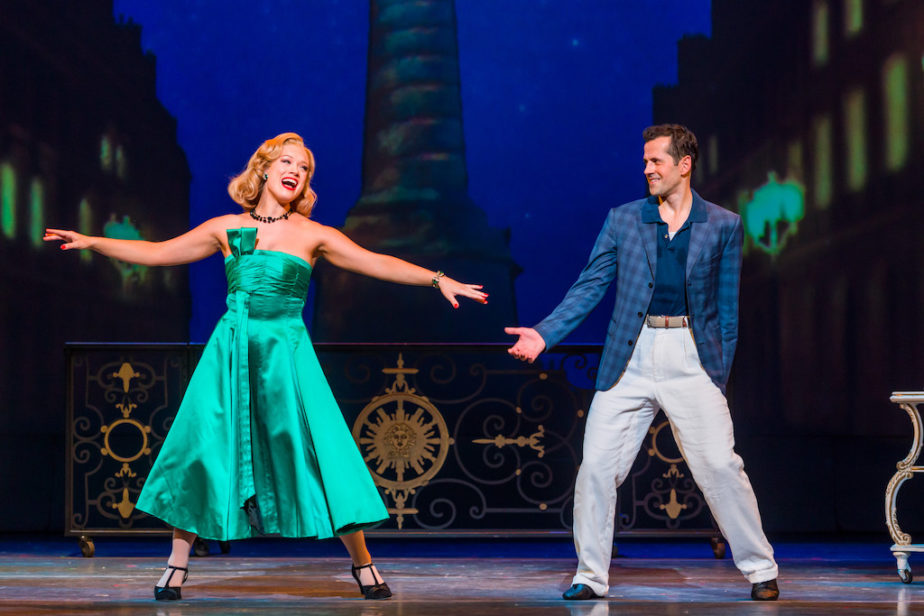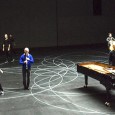Super glitzy, full of colour and movement, fabulous music and mesmerising dance scenes, An American in Paris is spectacular. Inspired by Gershwin’s 1928 orchestral score and the 1951 multi-award-winning movie of the same name, Brit Christopher Wheeldon’s choreography is precise and clever. The ensemble, comprising musical theatre performers and members of the Australian Ballet, is a delight to watch. Unlike the movie, this American in Paris is set in the immediate aftermath of the German occupation of the City of Light, and attempts a darker storyline, one that points up the struggles and divided loyalties of its citizens under Nazi rule. When the huge blood-red flags of the Third Reich tumble at the back of the set to be replaced by a tricolore, it is an inspiring and goosebumpy beginning.
Wheeldon’s production is topped and tailed by another American in Paris, Adam Hochberg (Jonathan Hickey), shifting the initial focus from the hero of the film GI Jerry Mulligan. Hochberg has been wounded by war and wounded by love, and – sitting alone by his piano, spotlit on a darkened stage – he’s here to remind us that all is not well in 1945 Paris.
But fear not, movie aficionados – the underlying plotline remains the same. And Robbie Fairchild (ex New York City Ballet) is as talented and handsome a bundle of energy as anyone could want. GI Jerry, now a struggling artist (of a moderniste bent, a là Jackson Pollock) is soon spotted by heiress Milo Davenport (Ashleigh Rubenach) and then suitably affronted at being treated as an escort. On the still-dark streets of Paris (and be ready for some marvellous sets), he soon falls for Lise (British Royal Ballet alumnus Leanne Cope) who is, of course, promised to another man, Henri Baudel (Sam Ward).
Despite the aforementioned spectacular dancing, a substantial orchestra and the enduringly marvellous Gershwin Brothers songbook (with numbers like S’Wonderful, I Got Rhythm and Shall We Dance, what’s not to love?), I found myself wondering at this curious hybrid of musical theatre, ballet and drama. And waiting for the tap. (My fault: I had watched the 1951 movie in preparation for this show and was expecting much tap-dancing enthusiasm and heel-toe clicking.) Which is not in any way to denigrate the superb balletic talents and fabulous energy of Fairchild. Nor Cope. The pair originated the roles of Jerry and Lise in the original Paris, Broadway, and London productions and have been justly lauded since. As for any on-stage chemistry between these about-to-be-lovers – sorry, I didn’t feel it.
This Tony Award-winning American in Paris brings many glorious numbers to the stage, scenes if you will. All superbly executed, but some seemed superfluous to the story line, like the opening number of Act II, Fidgety Feet. It comes as the ballet dancers perform, on a stage within the stage, a piece coyly introduced as The Eclipse of Uranus. (Cue laughter). But the on-stage audience, as you have probably guessed, soon get fidgety feet. And those feet just won’t stay still. Again, it’s a beautifully choreographed piece of dancing and fascinating to watch. But not sure what it was doing there.
Act II also brought the tap I had been missing. Henri (lovely performances from Ward), who must defy his family to become the entertainer he has always dreamed he will be, makes his endearingly nervous and stumbling debut in a small Parisian nightclub but, in the twinkling of a bespangled shoe, the whole company is on stage, headdress feathers, glitter and all, to give us I’ll Build a Stairway to Paradise. It is brilliantly done, was rapturously received and all credit to the performers. Henri’s parents are suitably shocked, and I will not spoil the outcome.
Underneath An American in Paris there is a good storyline struggling to be heard. German occupation brought Paris to its knees, tested its citizens’ morals and loyalties. There is an article about it in the program. The denouements in this story, when they come, are sprinkled in rather weakly (digs at the Vichy French and the terror of hiding Jews from Nazis), and sometimes the dialogue is so wooden it is distracting. Jerry’s proclamation about doing the right thing at the wrong time, or the right thing at the right time or something like that, was so expositional I can’t quite remember it. I do remember these:
Jerry: ‘It helps if they have stood in your shoes.’ Milo (looking at her gold heels). ‘These might pinch.’
Later, Lise to Adam (handing him a rose): ‘You are my American in Paris.’ (Hello, Jerry! Are you hearing this?)
And then Jerry to Milo: ‘You’re a peach.’ (Just what every rejected girl wants to hear.)
The sets and costumes (both Bob Crowley) are colourful and lavish; Wheeldon as director and choreographer moves things along at a cracking pace. An American in Paris has nearly everything in spades. Except a sense of passion, as in desire between the two leads. Others can disagree, but I couldn’t see it. These reservations aside, Wheeldon’s American certainly transports us into another world, and it’s no spoiler to say the ending is happy.
It runs at the Theatre Royal until 12 June; a season in Perth follows.
Tickets from $69.95 to $239.95 (plus $8.95 handling fee).
Details www.theatreroyal.com




